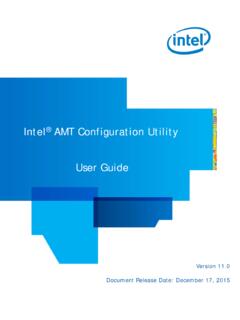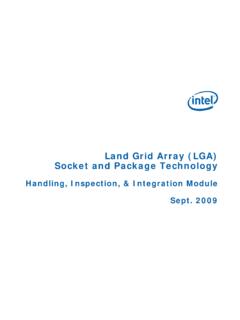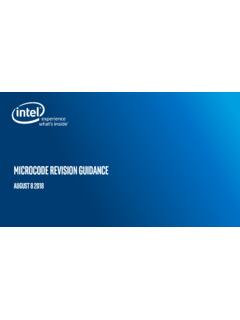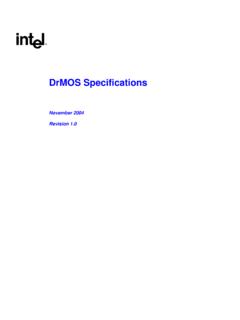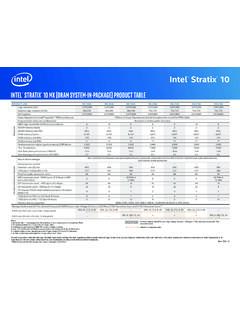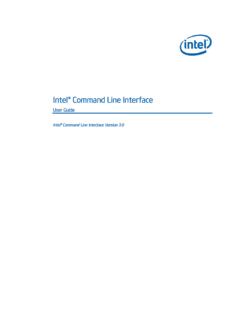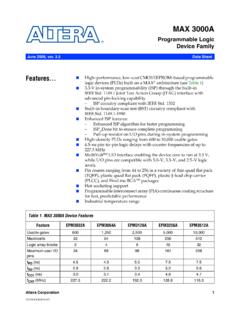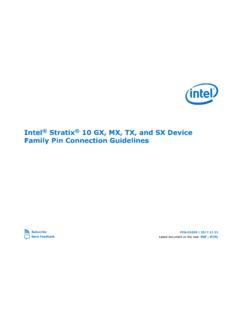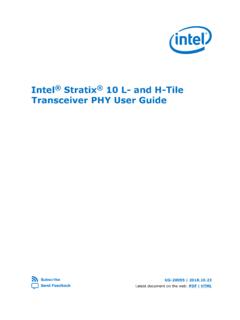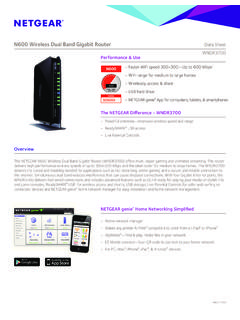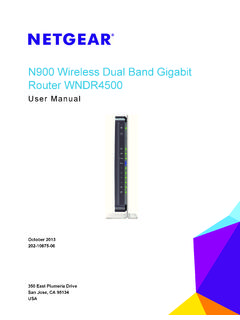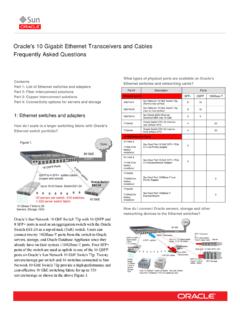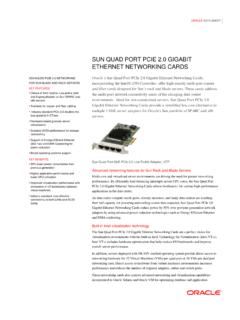Transcription of Intel® 82576 Gigabit Ethernet Controller
1 The Intelligent Way to ConnectThe intel 82576 Gigabit Ethernet Controller is a compact component with two fully integrated Gigabit Ethernet Media Access Control (MAC) and physical layer (PHY) ports. This device uses the PCI Express* ( GT/s) [x4, x2, and x1] interface. The intel 82576 Gigabit Ethernet Controller provides two IEEE * Ethernet interfaces for 1000 BASE-T, 100 BASE-TX, and 10 BASE-T applications. Both ports also integrate a Serializer-Deserializer (SerDes) interface to support 1000 BASE-SX/LX/BX (optical fiber), Gigabit Ethernet backplane applications and exter-nal PHYs connected either on board or via SFP connectors using SGMII signaling. intel 82576 Gigabit Ethernet Controller provides hardware assists for auto sensing and switching between Copper and SerDes/SGMII Design FeaturesThe intel 82576 Gigabit Ethernet Controller provides high- performance dual-port Gigabit connectivity in a multi-core platform as well as in a virtualized platform.
2 In a multi-core platform it supports different technologies including intel QuickData Technology, MSI-X, Low Latency Interrupts and others, that help accelerate the data across the platform thereby improving application response times. In a virtualized environment it supports intel Virtualization Technology1 for Connectivity that helps improve the I/O performance by reducing the I/O overhead on a virtualized I/O technologies on a multi-core platform make use of the multiple queues and multiple interrupt vectors available on the Controller . These queues and interrupt vectors help in load balancing the data and the interrupts amongst themselves in order to lower CPU utilization and improve the overall system performance.
3 Depending upon the latency sensitivity of the data, the Low Latency Interrupts feature automatically modu- lates the time interval between the interrupts, lowering CPU utilization BriefIntel 82576 Gigabit Ethernet ControllerNetwork ConnectivityIntel 82576 Gigabit Ethernet Controller High-performance, Dual-Port Gigabit Network Connectivity for multi-core and virtualized platforms High-performing, PCI Express* 10/100/1000 Ethernet connection Dual-port, single-chip configuration simplifies designs Improves performance and throughput by reducing the I/O overhead due to the software virtualization layer Provides near-native performance and data protection with direct connectivity to the virtual machines Enhanced support for passthrough traffic to board management controllerIntel Virtualization Technology for Connectivity is a suite of hardware assists provided on the I/O Controller that improves the overall system performance by lowering the I/O overhead on a virtualized environment.
4 The technologies include intel I/O Accel-eration Technology ( intel I/OAT), Virtual Machine Device Queues and PCI-SIG SR-IOV implementation. intel I/OAT comprises different stateless offloads (checksum and TCP Segmentation offload), MSI-X and other features to enhance data acceleration across the virtualized platform. Virtual Machine Device Queues help improve data processing by offloading the data sorting functionality from the software virtualization layer to the I/O Controller . PCI-SIG SR-IOV implementation helps direct connectivity to the virtual machines in order to provide them with near-native performance. It also provides data isolation between the virtual 82576 Gigabit Ethernet Controller also provides security features like IPsec offload and LinkSec.
5 *1 IPsec offload significantly improves the system performance by delivering near-line-rate throughput with reduced CPU utilization. This performance gain is achieved by offloading the IPsec functionality on to the I/O silicon. IPsec provides protection between the host and destina-tion devices of a communication network. LinkSec is a new IEEE industry-standard feature that helps in providing data protection in the network. The IEEE and IEEE protocols help to provide this protection between two devices in a hop-by-hop manner along the communication Management FeaturesThe intel 82576 Gigabit Ethernet Controller enables network manageability implementations required by IT personnel for remote control and alerting (IPMI, KVM Redirection, Media Redirection) by sharing the LAN port and providing standard interfaces to a Board Management Controller (BMC).
6 The communication to the BMC is available either through an on-board System Management Bus (SMBus) port or through the DMTF defined NC-SI. The Controller provides filtering capabilities to determine which traffic is forwarded to the BMC. The Controller also supports the new IEEE 1588 Precision Time Control standard. This standard provides a time synch capability that synchronizes the internal clocks according to a network master ConfigurationThe intel 82576 Gigabit Ethernet Controller can be configured using an EEPROM, but can also be used in an EEPROM-less configuration. The internal PHYs can be controlled using an internal IEEE MDIO register set. External PHYs can be controlled either using an IEEE MDIO interface or using a 2-wire interface as defined in the SFP module intel 82576 Gigabit Ethernet Controller package is a 25 mm x 25 mm, 576-pin Flip-Chip Ball Grid Array (FC-BGA).
7 intel 82576 Gigabit Ethernet Controller is pin compatible with intel 82575 Gigabit Ethernet Express* FeaturesPCI Express* ( ) Supports x4/x2/x1 lanes Supports configurable completion timeoutVital Product Data (VPD) support Allows OEMs to keep proprietary inventory information in the EEPROM of the deviceCompatible extensions to PCI power management and ACPI Efficient power managementGigabit MAC/PHY Advanced FeaturesWide, pipelined internal data path architecture Low-latency data handling Superior direct memory access (DMA) transfer-rate performanceSupport for transmission and reception of packets up to KBytes ( Jumbo Frames) Enables higher and better throughput of dataIEEE * auto-negotiation Automatic link configuration for speed, duplex, and flow control Improves performance and reliabilityIEEE * compliant flow-control support with software-controllable pause times and threshold values Frame loss from receive overruns reduced Control over the transmissions of pause frames through software or hardware triggeringSupported cable length is more than 100 meters Reliable operation at greater distancesIntegrated PHY for 10/100/1000 Mbps Smaller footprint.
8 Lower power dissipation compared to multi-chip MAC and PHY solutionsIEEE PHY compliance and compatibility Robust operation over installed base of Category-5 twisted-pair cablingBuilt-in cable diagnostics and adjustments for cable faults Improved end user troubleshooting Tolerance of common wiring faultsFeaturesBenefitsI/O features for Multi-core processor serversIntel QuickData Technology DMA Engine: enhances data acceleration across the platform (network, chipset, processor), thereby lowering CPU utilization Direct Cache Access (DCA): allows the processor to pre-fetch the data from memory, thereby avoiding cache misses and improving service level agreements (SLA) of the applicationsMSI-X support Allows load balancing of interrupt handling between different CPUs/cores, thereby minimizing the overhead of data interruptsLow Latency Interrupts Based on the sensitivity of the incoming data it can automatically moderate the time intervals between the interruptsHeader split and replication in receive Helps the driver to focus on the relevant part of the packet without the need to parse itMultiple Queues (8 queues/port)
9 Network packet handling without waiting or buffer overflow, providing efficient packet prioritizationTx/Rx IP, SCTP, TCP, and UDP checksum offloading (IPv4, IPv6) capabilities (IPv4, IPv6) Lower processor utilization Checksum and segmentation capability extended to new standard packet typeTx TCP segmentation offload (IPv4, IPv6) Increased throughput and lower processor utilization Compatible with large send offload feature (in Microsoft Windows* XP)Receive Side Scaling for Windows environment and Scalable I/O for Linux* environments (IPv4, IPv6, TCP/UDP) This technology enables the affinitization of the interrupts to the processor cores in order to improve the CPU utilization rateIPsec offload Offloads IPsec capability on to the silicon hardware instead of the software to significantly improve I/O throughput and CPU utilization rateLinkSec*2 Layer 2 data protection solution that provides encryption and authentication ability between two individual devices (routers, switches, etc)
10 IPv6 offloading Checksum and segmentation capability extended to new standard packet typeAdvanced packet filtering 24 exact-matched packets for unicast and multicast frames 4096-bit hash filter for unicast frames Lower processor utilization Promiscuous (unicast and multicast) transfer mode support Optional filtering of invalid framesIEEE virtual local area network (VLAN) support with VLAN tag insertion, stripping and packet filtering for up to 4096 VLAN tags Ability to create multiple VLAN segmentsVirtualization FeaturesVirtual Machine Device Queues (VMDq) (8 queues/port available for this functionality) Offloads the data sorting functionality from the Hypervisor to the silicon, thereby improving data throughput and CPU utilization Provides QoS feature on the Tx data by providing round robin servicing and preventing head of line blocking Sorting based on MAC addresses and VLAN VMDq Enhanced QoS feature by providing weighted round robin servicing for the Tx data Provides loopback functionality, where data transfer between the virtual machines within the same physical server need not go out on to the wire and come back in.
